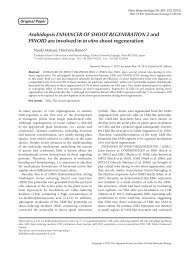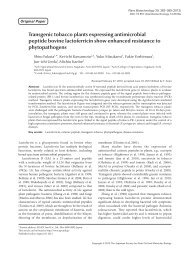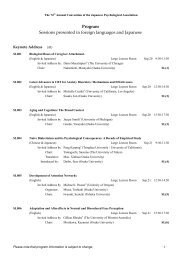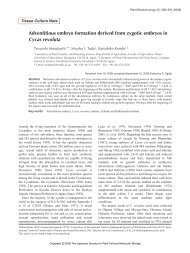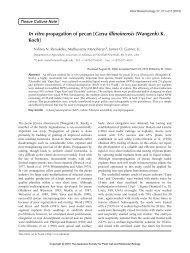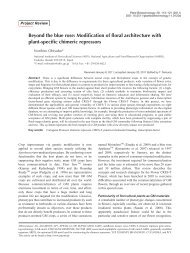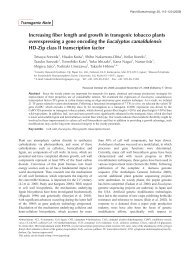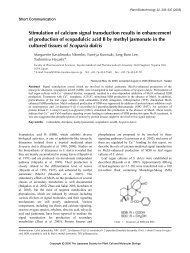Plant Biotechnol. 28(2): 131-140 (2011) - Wdc-jp.biz
Plant Biotechnol. 28(2): 131-140 (2011) - Wdc-jp.biz
Plant Biotechnol. 28(2): 131-140 (2011) - Wdc-jp.biz
You also want an ePaper? Increase the reach of your titles
YUMPU automatically turns print PDFs into web optimized ePapers that Google loves.
T. Narumi et al. 133<br />
system with a photodiode array detector (Agilent Technologies,<br />
CA, USA) and an Inertsil ODS-2 column (4.6250 mm; GL<br />
Science, Tokyo, Japan) at 40°C at a flow rate of 0.8 ml min 1 .<br />
A linear gradient of 20%–100% solvent B (1.5% H 3 PO 4 , 20%<br />
CH 3 CO 2 H, 25% CH 3 CN) in solvent A (1.5% H 3 PO 4 ) was run<br />
for 40 min. Anthocyanins and flavonoids were detected based<br />
on their absorption spectra at 200–600 nm, and their<br />
concentrations were calculated as the cyanidin 3-rutinoside<br />
equivalent by absorption at 530 nm and the quercetin 3-<br />
rutinoside equivalent by absorption at 360 nm, respectively.<br />
Results and discussion<br />
Generation of transgenic torenia and<br />
chrysanthemum expressing TCP3-SRDX<br />
To investigate whether the Arabidopsis chimeric TCP3<br />
repressor (TCP3-SRDX) induces wavy leaves and petals<br />
in horticultural plants, we produced transgenic torenia<br />
and chrysanthemum expressing TCP3-SRDX. As<br />
negative controls, we introduced a TCP3 overexpressor<br />
gene (TCP3-ox) and a modified TCP3 chimeric repressor<br />
gene in which SRDX had been mutated (TCP3-mSRDX;<br />
Koyama et al. 2007). We obtained more than 10 torenia<br />
and 20 chrysanthemum transgenic plants for each<br />
transformation (Table S1) and examined their<br />
phenotypes in detail.<br />
Phenotype of TCP3-SRDX torenia<br />
TCP3-SRDX torenia exhibited a weak dwarf phenotype<br />
probably due to reduction in internode length (Figure<br />
1A). In addition, it demonstrated distinct morphological<br />
and physiological changes in petals and leaves. As shown<br />
in Figure 1B, TCP3-SRDX torenia exhibited fringed<br />
margins mainly in the dorsal petal. Moreover,<br />
anthocyanin pigmentation, which imparts purple color to<br />
the petal lip region of the wild type, was clearly reduced.<br />
TCP3-SRDX torenia also exhibited wavy blades and<br />
fringed margins in leaves as in TCP3-SRDX Arabidopsis<br />
(Koyama et al. 2007) and cincinnata (cin)-756 mutant of<br />
Antirrhinum (Nath et al. 2003). In contrast, TCP3-<br />
mSRDX and TCP3-ox had no effect when the transgenes<br />
were expressed at a certain level in each transgenic plant<br />
(Figure S1A). Phenotypes of TCP3-SRDX torenia plants<br />
were classified into 3 groups by petal color and shape:<br />
type I, normal flower (wild type); type II, flowers with<br />
wavy, fringed marginal petals; type III, flowers with palecolored<br />
petals and a wavy, fringed margin (Figure 1C).<br />
In Arabidopsis, the pistils of TCP3-SRDX plants were<br />
significantly shorter than those of the wild type (Koyama<br />
et al. 2007). To confirm whether this held true for TCP3-<br />
SRDX torenia, we microscopically observed their pistils.<br />
As shown in Figures 1D and S2, TCP3-SRDX torenia<br />
showed pistils of reduced length, as in Arabidopsis. In<br />
addition, stigma width and ovary length of TCP3-SRDX<br />
torenia pistils were somewhat greater compared with<br />
those of the wild type (Figure S2).<br />
Morphological changes in petal and stigma<br />
epidermal cells of TCP3-SRDX torenia<br />
To further characterize the phenotype of TCP3-SRDX<br />
torenia petal and stigma, we performed scanning electron<br />
microscopy (SEM) of petals and pistils of the wild type<br />
and a type III TCP3-SRDX torenia 5010-14. In wildtype<br />
plants, the epidermis of the adaxial surface of the<br />
petal lip region showed homogenous conical epidermal<br />
cells (Figure 2A) and that of the boundary region<br />
between the lip and the tube showed several spike-like<br />
cells in addition to conical cells (Figure 2B). The<br />
epidermis of the upper tube region showed increased<br />
numbers of elongated spike-like cells (Figure 2C).<br />
Unlike the wild type, TCP3-SRDX torenia exhibited a<br />
slightly increased number of spike-like cells not only in<br />
the boundary region but also in the petal lip region<br />
(Figures 2D, E). There was no difference between these<br />
plants with regard to the organization of the upper tube<br />
region (Figure 2C, F). These results suggest that the cell<br />
identity of the petal lip region in TCP3-SRDX torenia<br />
was altered to that of the boundary region; therefore, the<br />
petal lip color became paler, as in the tube region. This<br />
idea is supported by our finding that the total amount of<br />
flavonoids in TCP3-SRDX torenia petals was clearly<br />
reduced compared with that in wild-type petals, and the<br />
anthocyanin/flavonoids ratio in the whole petals of type<br />
III TCP3-SRDX torenia 5010-14 (0.15) was similar to<br />
that in the petal tube of wild-type (0.17, Figure S3).<br />
Therefore, the phenotype of TCP3-SRDX torenia petals<br />
may have arisen through altered regulation of cell<br />
identity. Similar results were reported in the cincinnata<br />
mutant of Antirrhinum and transgenic Arabidopsis in<br />
which a chimeric repressor from TCP5 (TCP5-SRDX), a<br />
TCP3-type transcription factor, was expressed (Crawford<br />
et al. 2004; T. Koyama, personal communication).<br />
A morphological change in the epidermal cells was<br />
observed in type III TCP3-SRDX torenia pistils (Figure<br />
3). Epidermal cells of the stigma surface of TCP3-SRDX<br />
torenia showed a smooth surface while those of the wild<br />
type showed a rough surface (Figure 3A). Furthermore,<br />
in TCP3-SRDX torenia, trichome-like cells on the style<br />
surface were observed at the boundary region of style<br />
and ovary, and capitate glandular cell-like structures,<br />
usually observed in petals, were observed on the lateral<br />
area of the style (Figure 3B). Thus, TCP3-SRDX may<br />
affect epidermal cell differentiation in both petals and<br />
pistils of torenia. In Antirrhinum, mutant analyses<br />
revealed that MIXTA and AmMYBML1–3 (MYB<br />
transcription factors) control petal epidermal cell<br />
differentiation and induce trichomes in carpels. MIXTA<br />
affects petal shape and size via the developmental<br />
control of conical epidermal cells when overexpressed in<br />
tobacco (Baumann et al. 2007; Glover et al. 1998; Martin



